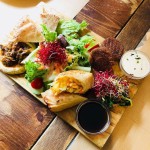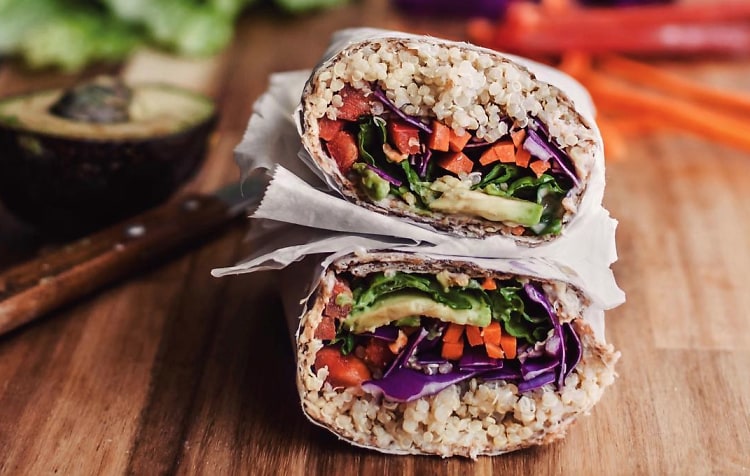
Old Fashioned Mom brings you Harpers BAZAAR.. Food Diaries with Yolanda Hadid

Old Fashioned Mom brings you Harpers BAZAAR.. Food Diaries with Yolanda Hadid

Discover Good Food’s hottest trends in food and drink for 2018, including meat-free burgers, alcohol-free spirits and more innovative ways to eat healthy.
It seems 2018 is set to be a year of even more adventurous veggie and vegan cuisine while the rise of hyper-local cooking and exciting advances in technology take a firmer hold on British food culture. Wondering what to expect from the future of food and drink? Check out the BBC Good Food team’s predictions for the coming year.
With fermenting, pickling and preserving reaching the mainstream, our panel agree that gut health is set to be a big food trend for 2018. This includes probiotics like kimchi, miso and kefir and prebiotics such as onions, garlic and other alliums.

Good Food columnist Tony Naylor cites non-alcoholic drinks as a growth area in the food and drink industry, and our supermarket forecasters say that health-conscious millennials are drinking booze less and less. Premium tonic waters with interesting flavours, non-alcoholic ‘spirits’ and botanical mixes are flooding in to fill a gap in the market.

Poke bowls are everyday food in Hawaii – essentially sushi without the fussy presentation. Still relatively hard to find, even in London, next year they will likely cross over into the mainstream. These bowls are endlessly customisable and can be economical, too.

We love exploring new seasonings and we’re not afraid of hot spices. Timut pepper, from Nepal, is spiky, zesty – surprisingly grapefruity – and leaves a tingly residual heat on the palate. It’s also been tipped by sous-chef.co.uk and supermarket giant Asda as being the next big condiment for 2018.

Good news for fans of a cuppa – tea is even more popular than before. Sales of herbal and green tea, in particular, continue to rise for consumption at home, so it’s likely that the small number of tea ‘bars’ that we’ve seen popping up may also start to proliferate on the high street. People are beginning to think of tea with the same reverence as coffee for its many varieties.

In the UK and many other countries now, there is a growing trend for dishes created with ingredients sourced within walking distance. One of the figureheads for this movement is Danish chef René Redzepi who is doing just that at his two-Michelin-starred Copenhagen restaurant Noma. Tony Naylor observes that at home, too, there are more and more “restaurants are applying a Redzepi-like sense of localism to their ingredients”.

Not available to buy yet, heme – pronounced ‘heem’ (from the Greek word for ‘blood’) – is at the cutting edge of food science, and is a possible stepping stone to more environmentally sustainable meat alternatives. Tech-food start-up Impossible Foods are already using it to bring a meaty quality to their plant-based burger including, yes, the bloodiness of meat cooked rare.

With more and more chefs embracing ingredients such as tofu, tempeh and quinoa, veganism is on the rise. Food blogger Angry Chef talks about redefined Indian cuisine (rich with pulses) as a growing trend, with restaurants taking dishes back to their plant-based roots with originality and mass appeal. There’ll be more meat-free days in 2018.

Having recently purchased Whole Foods, Amazon is now competing with a clutch of smaller outfits who specialise in delivering recipe kits to home chefs, which means an emerging trend is set to become even bigger. Tying in with this, the development of smart fridges will take the hassle out of ordering ingredients by snapping ‘shelfies’ of your food to keep you well-stocked. We can also look forward to more voice-operated gadgets such as Google Home and Alexa to record and order your shopping lists.

Mexican, Peruvian and Brazilian food along with Japanese-Mexican fusion could well be big this year. ‘Arepas’ [pronounced ‘uh-rey-puhs’, which are corn pizzas-cum-muffins], chicha [‘chee-chuh’, a fermented maize drink] and chulpe corn [‘chool-puh’, used to make snacks] will be prevalent,’ says Georgina Lunn, Product Development Manager at Sainsbury’s. Quinoa and chia seeds have peaked, but purple potatoes, white and purple corn, black quinoa and kiwicha seeds are on the up.

Luke Farrell from Dorset’s Ryewater Nursery, who has encyclopedic knowledge of Malaysian and Sichuan cuisines, is harvesting rare Asian plant varieties like som saa and pandan (Nigella reckons the latter is the avocado of 2018). Meanwhile, there’s sustainably farmed British tilapia in east London (growup.org.uk), with the waste produced used as fertiliser to grow veg. British farmers are even producing txuleton (pronounced chuleton), the Galician old ox or dairy beef that foodies go wild for.

Brunch, brinner, lunch… are you confused too? Now, we have a fourth meal to contend with. ‘We’ve been watching the fourth meal for months,’ says Jonathan Moore, Waitrose’s executive chef. ‘We’re eating differently. We have breakfast for dinner, dinner for lunch – everything is less structured. The fourth is the final meal, which is normally a treat.’ So, four meals a day – if you have the appetite for it!

The health-conscious will be consuming nootropics – that’s brain food, to you and me – according to trends prediction agency Pearlfisher. Gut health is still a major focus but cognition may now start to take over. Look out for turmeric, salmon, eggs, dandelion greens and jícama (Mexican yam).

Grant Harrington, of Butter Culture, is elevating the humble yellow block. After a year of research into dairy fermentation, when he built a cabin on a farm in Oxfordshire, the ex-Fäviken chef started supplying butter locally. Now, his rich, buttercup-hued fat, heaped with naturally occurring diacetyl acid – the stuff that makes butter buttery – is omnipresent. Diners are eulogising it in restaurants from Sat Bains in Nottingham to London’s Bibendum.

Zoe Adjonyoh’s recent cookbook, Zoe’s Ghana Kitchen, about growing up eating grilled tilapia and gingery Scotch bonnet stew, has been influential. Thanks to her, ‘there is scope to show customers how to use different spices,’ says M&S’s Head of Food Product Direction and Innovation, Cathy Chapman. Additionally, Yeo Valley is releasing a limited-edition baobab and vanilla yogurt.

Written By: BBC Good Food team


And while there are certainly plenty of suitable options for the health-conscious out East, the Hamptons is finally getting a 100%, totally vegan café. The Plant Based Coffee Shop, set to open this June, is the brainchild of Marley and Lennon Ficalora, two vegetarian-raised brothers who set out to create an establishment which would “make healthy plant-based food affordable and accessible to everyone.”
So, for those who want to maintain their Gwyneth-approved lifestyle (or just try it out), this café is the best thing to hit the East End since the SoulCycle BARN.

Plant Based Coffee Shop, 2487 Main Street, Bridgehampton
The Plant Based Coffee shop will feature cafe staples such as wraps and bowls, along with cold brew and kombucha on tap. It will be open daily from 10 am to 4 pm. Stay tuned!
Written By: Danielle Spoleti